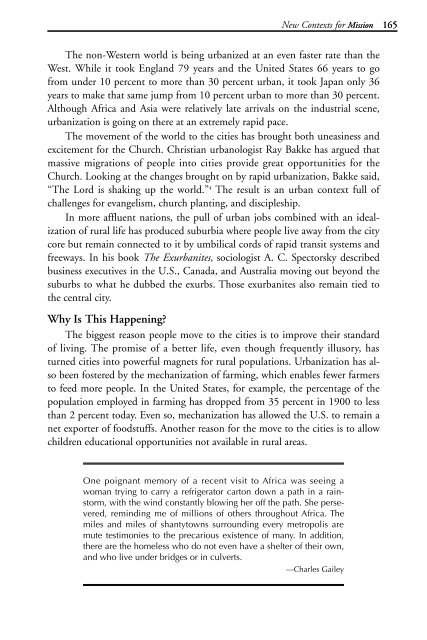discovering missions - Southern Nazarene University
discovering missions - Southern Nazarene University
discovering missions - Southern Nazarene University
Create successful ePaper yourself
Turn your PDF publications into a flip-book with our unique Google optimized e-Paper software.
245187 Disc Missions ins 9/6/07 1:04 PM Page 165<br />
New Contexts for Mission 165 165<br />
The non-Western world is being urbanized at an even faster rate than the<br />
West. While it took England 79 years and the United States 66 years to go<br />
from under 10 percent to more than 30 percent urban, it took Japan only 36<br />
years to make that same jump from 10 percent urban to more than 30 percent.<br />
Although Africa and Asia were relatively late arrivals on the industrial scene,<br />
urbanization is going on there at an extremely rapid pace.<br />
The movement of the world to the cities has brought both uneasiness and<br />
excitement for the Church. Christian urbanologist Ray Bakke has argued that<br />
massive migrations of people into cities provide great opportunities for the<br />
Church. Looking at the changes brought on by rapid urbanization, Bakke said,<br />
“The Lord is shaking up the world.” 4 The result is an urban context full of<br />
challenges for evangelism, church planting, and discipleship.<br />
In more affluent nations, the pull of urban jobs combined with an idealization<br />
of rural life has produced suburbia where people live away from the city<br />
core but remain connected to it by umbilical cords of rapid transit systems and<br />
freeways. In his book The Exurbanites, sociologist A. C. Spectorsky described<br />
business executives in the U.S., Canada, and Australia moving out beyond the<br />
suburbs to what he dubbed the exurbs. Those exurbanites also remain tied to<br />
the central city.<br />
Why Is This Happening?<br />
The biggest reason people move to the cities is to improve their standard<br />
of living. The promise of a better life, even though frequently illusory, has<br />
turned cities into powerful magnets for rural populations. Urbanization has also<br />
been fostered by the mechanization of farming, which enables fewer farmers<br />
to feed more people. In the United States, for example, the percentage of the<br />
population employed in farming has dropped from 35 percent in 1900 to less<br />
than 2 percent today. Even so, mechanization has allowed the U.S. to remain a<br />
net exporter of foodstuffs. Another reason for the move to the cities is to allow<br />
children educational opportunities not available in rural areas.<br />
One poignant memory of a recent visit to Africa was seeing a<br />
woman trying to carry a refrigerator carton down a path in a rainstorm,<br />
with the wind constantly blowing her off the path. She persevered,<br />
reminding me of millions of others throughout Africa. The<br />
miles and miles of shantytowns surrounding every metropolis are<br />
mute testimonies to the precarious existence of many. In addition,<br />
there are the homeless who do not even have a shelter of their own,<br />
and who live under bridges or in culverts.<br />
—Charles Gailey

















